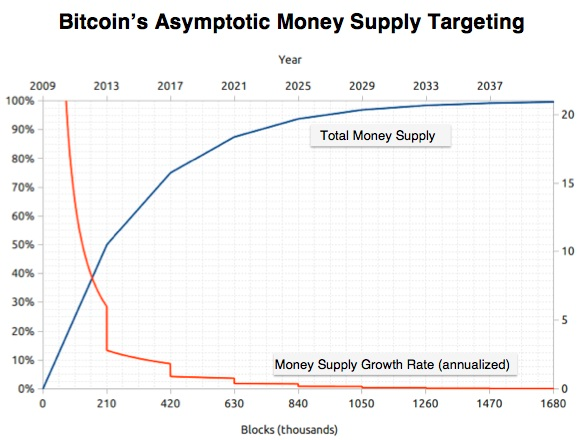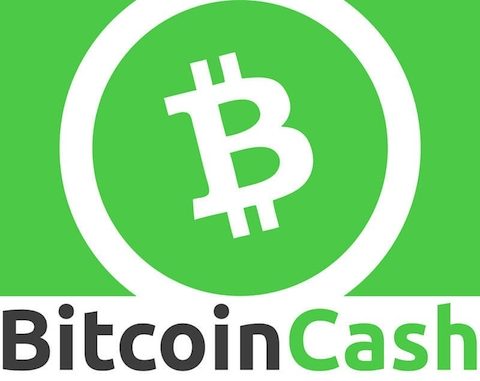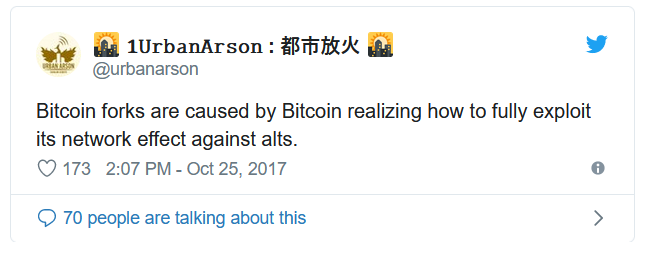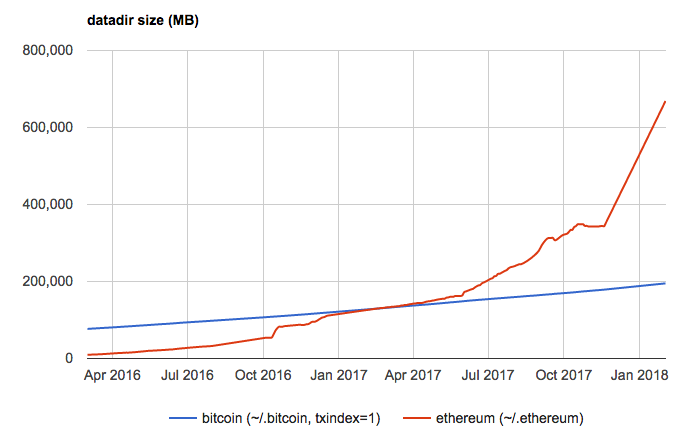The Many Faces of Bitcoin
The Many Faces of Bitcoin
By Murad Mahmudov & Adam Taché
Posted April 10, 2018
To nocoiners, gold-bugs, and Keynesians, the cryptocurrency space is best seen as a parasite infecting millennials with technobabble, forcing them to spout economic gibberish, and sucking them into believing the pipedream that a crypto-anarchist society could exist. To believers in the technology, cryptocurrencies represent an escape from the imprisonment of the traditional financial system in which they are forced to participate by being born; a system which has been plagued by inflationary monetary policy, monopoly by nation-states on money creation, malinvestment, and debt. To believers, cryptocurrencies are a starting point to rebuild honesty and a true measure of value in society among borderless, apolitical and decentralized systems.
The most prominent and powerful of the cryptocurrency communities — the Bitcoin community — has fractured into multiple factions based on desires for various directions to take the protocol and tribalism over different projects altogether. This article will explain some of the current motives driving these ideologies and try to express the reasoning behind this schism.
Although this article will be split into four main sections, there is certainly some overlapping thought between individuals who espouse these theories. The two schools of thought which we outline initially — bitcoin, first and foremost, as a store of value, and bitcoin cash as digital cash — are typically considered more mainstream, whereas the last two — Bitcoin as catalyst for something John Nash called “Ideal Money,” leading to bitcoin-backed fiat currencies, and finally, looking at Bitcoin from the perspective of information theory — are less commonly known.
Four Theories About Bitcoin
Bitcoin was the first decentralized cryptocurrency ever created. It was released in 2009 as the culmination of nearly two decades of discourse on the key concepts within the cypherpunk community. It was cited by the anonymous founder(s) Satoshi Nakamoto to be inspired by Bitgold by Nick Szabo and B-Money by Wei Dai, two earlier attempts by well-known members at creating functional electronic currency.
Most individuals within the Bitcoin community envision an endgame where an implementation of Bitcoin will be a massively adopted cryptocurrency that is both a store of value and a medium of exchange. They see bitcoin eventually being the predominant global currency. However, the ideology then diverges sharply on on how this can be accomplished, and which priorities should take precedence along the way.
Bitcoin As Money
Bitcoin presents us with an opportunity to reinvent gold, or even rethink money for the digital future. A number of economists have suggested that it may be more appropriate to evaluate items based on their degree of moneyness. According to this thinking, it isn’t that something either is or is not money; on the contrary, many items can play a monetary role and some items can play this role more effectively than others. In a number of ways, bitcoins have a high degree of moneyness. They are more portable, durable, divisible, and scarce than both gold and government fiat currency.
As of today, bitcoins can best be described as digital commodities with monetary properties. According to the Bitcoin Maximalist interpretation of monetary history, it is likely that a new, scarce form of money would evolve roughly along the following lines:
- Collectible
-
- Store of Value
-
- Medium of Exchange
-
- Unit of Account.
Proponents of bitcoins as digital cash believe that utility should initially take precedence over store of value, and prioritize attaining the medium of exchange role before store of value by making payments as cheap as possible.
Those who believe bitcoin will become the future global monetary standard ascribe current volatility to the fact that bitcoin is undergoing the process of monetization, and that a global cognitive shift is slowly occurring. In their view, despite great volatility, the long-term parabolic ascent of the price is a testament to more and more people believing in a future world where Bitcoin is widely used.
Crypto-Austrians who consider themselves Rothbardians, such as author Saifedean Ammous, believe that bitcoin’s disinflationary nature and cap on supply makes it the most sound money ever invented. They believe that bitcoin, with its fixed monetary supply, is the only fair form of money, as well as one which allows for the most efficient capital allocation by individuals and most efficient price signalling by the market as a whole.
Many individuals in this group are against the idea of fractional-reserve banking and consider it to be fraudulent. They believe that a fractional-reserve banking system is unlikely to emerge atop bitcoin, as bitcoins lack the physical centralization of gold, which forced settlements and clearance to necessarily pass through centralized choke-points, allowing governments to have complete control over the money supply, transmission, and the monetary regime at large. The governments had so much control that they were able to get rid of the gold-standard (which was organically chosen by the market over centuries) and introduce their own fiat standards, not backed by any commodity.
These individuals believe that fractional-reserve systems are simply unsustainable in the long run without lenders of last resort, which do not inherently exist in Bitcoin, and that people would be unwilling to accept bitcoin-substitutes in the market.
Those in the “Free Banking” wing of the Austrian school, such as George Selgin and Lawrence White, believe that bitcoin’s strictly fixed-supply and lack of lenders of last resort do not technically prevent a competitive system of fractional-reserve banks and entities arising atop bitcoin, or in an economy where bitcoin is the defacto monetary standard.
It is clear that there is a chance that bitcoin can, at the very least, emerge as a mildly volatile digital commodity, a store of value akin to digital gold. However, doubts remain whether it will transcend the raw store of value role and achieve low enough volatility to become a global medium of exchange and a unit of account.
Some believe that, due to its strictly inelastic supply, bitcoin is unlikely to be stable in its purchasing power anytime soon, if ever, and that people prefer for their day-to-day currency to be stable in purchasing power. These people have expressed excitement about the emergence of cryptocurrencies with more flexible and self-regulating monetary policies built in. For example, stablecoins aim to peg their market value against another form of value, such as the USD or a basket of goods, using an algorithmic central bank.
Others believe that, despite bitcoin’s strictly inelastic supply, bitcoin is a perfect solution to John Nash’s Ideal Money proposal that he worked on for over fifty years. Nash, a Nobel Laureate in Economics, proposed that central banks could inflation-target their currencies against an apolitical index to achieve international relational stability of all state currencies. In response to increasing demand for bitcoin, some believe banks will value target their currencies against bitcoin as a basis for the standardization of the value of money.
Deflationary Death Spiral
Mainstream, Keynesian, and Monetarist economists have expressed concerns with Bitcoin’s fixed-supply. They fear the possibility of harsh deflationary pressures if bitcoin becomes the predominant currency through the process known as hyperbitcoinization.
Their fear is that the inability to expand the money supply would result in bitcoin’s purchasing power growing by 2–3% per annum, roughly in line with the growth rates of global economic output. Some have expressed concerns that deflationary economics might reduce aggregate demand in the present and the near-term, result in excessive savings and hoarding of money, and produce less consumption, investment and entrepreneurial risk-taking by individuals.
Austrian economists believe that the fears associated with a deflationary form of money are overblown and that the ‘deflationary spiral’ is a myth. Austrian’s counter the Keynesian and Monetarists concerns that the delay in spending doesn’t last in perpetuity by reminding them that this spending is merely delayed into the future. People will now have a lower time-preference and that instead of buying “useless” things with their “hot potato” decaying money, they will turn their attention to long-term productivity.
They also believe that business profit margins will not be hurt because not only would product prices, but also business costs, deflate at the same rate, leaving the profit margins unchanged. Austrians believe that deflation is absolutely normal, and absent central control on the money supply, both capitalism and technology are naturally deflationary phenomenons. This can be seen in the less-regulated electronics industry, where increased storage/memory/compute capacities are becoming cheaper every year.
According to Austrians, it is the central bank inflationary fiat printing that exacerbates recessions and business cycles, as the perpetually-decaying money embeds the citizenry constant anxiety and stress, resulting in not well though-out investments and expenditures, collectively referred to as ‘malinvestment’. These malinvestments are typically inefficient allocations of capital, which are unlikely to result in personal gains, societal gains, productivity, or capital stock.
First Theory: BTC as a tamper-proof store of value.
Tenets: Sound Money. Set-in-stone monetary policy. Full-node affordability. Sovereign-grade censorship-resistance. Maximized decentralization and security.

Individuals that fall within the Bitcoin-as-sound-money camp generally believe BTC is the only legitimate cryptoasset, with everything else ranging from being entirely useless at best to blatant scams at worst. Commonly called Bitcoin Maximalists, they desire “sound money” by the Austrian Economic School definition, that cannot be inflated away or be at risk of confiscation, as the case was in 1933 when Executive Order 6102, issued by Franklin D. Roosevelt, made hoarding gold illegal in the United States.
These individuals believe that, for the foreseeable future, the goal of the Bitcoin project isn’t to facilitate the buying of coffee, but to become “high-powered” money, an even better form of gold. They claim it to be a digital asset superior to physical gold due to a truly limited supply and more deflationary emission. They also claim that, if used properly, it is unseizable, unhackable, arbitrarily unprintable, and is an attempt to engineer a superior form of money. Bitcoin is often discussed as a settlement network where the raw block space is not meant to facilitate small-value individual transactions. It is believed, rather, that its usage is for settling transactions of a larger value, where fees are less of an issue. This would likely include once-in-a-while settlement transactions of secondary payment solutions, for example, settling millions of Lightning Network payments in one finalizing transaction on the blockchain.
Although there are many brilliant concepts that were first brought together in Bitcoin, many Bitcoin Maximalists believe the mining difficulty adjustment may be the most ingenious, as it allows for true digital scarcity that is tied to the external, physical world. Saifedean Ammous is one of the most vocal and prominent BTC Maximalists, and in his new book, The Bitcoin Standard, he states that it is Bitcoin’s high stock-to-flow ratio coupled with its untamperable monetary policy that will eventually make it both the most attractive and the most robust store of value.
As of now, most bitcoin holders insist on not spending, a common statement being, “it would be foolish to spend when the price can still increase by a factor of 100x or more.” Instead, many are hoarding the asset, which has become known colloquially as “hodling.” For them, hodling is the main use case of Bitcoin during the time before the Tipping Point. The positive feedback loop of hodling and the price increasing encourages an ever-growing army of hodlers. This army in turn collectively increase both the value of the asset and the desirability to hoard it, as supply available on the market becomes increasingly scarcer.
This logic is nicely illustrated by Pierre Rochard in the diagram below to show that hoarding may create a positive feedback loop to increase the BTC price, resulting in increased mining profitability, hashing power, user adoption, and more.
 Bitcoin Market Components
Bitcoin Market Components
Bitcoin Maximalists hold the opinion that the key element of Bitcoin is the money it represents, rather than technology behind it. They cite Bitcoin’s “perfect monetary policy” (illustrated in the graph below) combined with the Lindy Effect due to first-mover advantage to explain why BTC will become and remain the dominant currency. The caveat being: Bitcoin must maintain its status as a peer-to-peer, decentralized system which produces a new block randomly, roughly every ten minutes. These Bitcoin Maximalists believe that as long as this is done, eventually hyperbitcoinization will occur, resulting in BTC being the dominant currency in existence.

In terms of monetary policy, Bitcoin Maximalists tend to believe that the hyper-deflationary total money supply of Bitcoin gives it the best monetary policy of any existing asset, and fractional reserve banking is rotten to the core. They prioritize saving and capital accumulation as opposed to superficial consumption. They believe, in line with Austrian school economists, that government meddling, especially with the money supply, causes malinvestment, makes interest rates artificially low, and enriches a select few at the expense of many.
Bitcoin Maximalists believe that bitcoin as sound money is to be accomplished through maximizing both the collective and individual security within the system. Currently, the Bitcoin blockchain is by far the most difficult to tamper with of any cryptocurrency in existence, based on hashrate alone. As of April 2018, it is estimated that transactions in Bitcoin are currently secured by confirmations from a network of computing power that produces over 29 exa-hashes per second. This rate is estimated based upon the mining difficulty, which has approximately tripled in the last six months and has grown every year since the release of Bitcoin in 2009.
 Bitcoin Hashrate (as of April 2018)
Bitcoin Hashrate (as of April 2018)
Bitcoin Maximalists believe that the network hires miners to do one specific job: mine the blocks that full nodes determine to be valid. Thus, they believe users are in control of what Bitcoin validates, not miners. To facilitate this, Bitcoin Maximalists emphasize that users should attempt to be self-sovereign by controlling their own private keys and verifying their own transactions by running full nodes. By minimizing block size and data stored on-chain, users can still manage to run full nodes even on low-bandwidth connections. There are currently over 9000 reachable full nodes among over 100,000 total, which all store copies of the Bitcoin blockchain.
Bitcoin Core is the most dominant open source project that uses the Bitcoin protocol. The developers currently responsible for Bitcoin Core are primarily focused on supporting the Lightning Network and other payment channels. They also support CoinJoin for privacy, and are developing more support for side-chains as future second-layer or even third-layer solutions for payments emerge, MAST, and Schnorr signatures and signature aggregation in order to maximize how efficiently block space is used on the Bitcoin blockchain. They are also looking into implementing confidential transactions, potentially using Blockstream’s Elements Project. There is also a proposal to implement confidential transactions as a softfork, using segwit.
Second Theory: BCH as peer-to-peer Digital Cash
Tenets: Peer-to-peer, censorship-resistant, borderless cheap transfer of value, without middlemen. High on-chain throughput and on-chain utility. Set-in-stone monetary policy.

The members of the Bitcoin Cash community believe that Bitcoin should have unrestricted block sizes in order to facilitate peer-to-peer payments without bounds, and that Satoshi’s original intention was to create a peer-to-peer electronic currency, as opposed to something like digital gold. They generally cite the title and abstract of the Bitcoin whitepaper as proof of their correctness, as well as Satoshi’s statements regarding a phased-in approach to increase the block size, among other writings. These supporters generally believe that the Bitcoin system should not be a settlement layer solely for those who can afford to pay increasing fees, such as banks and other wealthy entities. They are completely against that use case for technological and ideological reasons, and they want to see most activity on-chain.
The implementation of Bitcoin that these individuals prefer is called Bitcoin Cash. It aims to gain adoption as a medium of exchange before becoming a store of value by keeping blocks large enough for nearly infinite transactions to take place. It aims to allow all users to transact on-chain, including those who may be underbanked or unbanked, some of whom earn as little as the equivalent of 2 dollars a day.
This Bitcoin fork to an alternate implementation was the result of increasingly differing opinions on the technological and social directions the Bitcoin community should head. One example is the disagreement between prominent developers on the implementation of a protocol change implemented in February of 2016, referred to as replace-by-fee. Bitcoin and Bitcoin Cash supporters clashed on this point of contention: some siding with Mike Hearn’s replace-by-fee counterargument, and some in favor of 0-confirmation transactions to allow for instantaneous payments to maximize utility of Bitcoin, and allow it to essentially be used the same as cash. The side in favor of bitcoin as cash often cites Satoshi’s vending machine example as reasoning for this always being desirable within the system. Still, others believe in researching alternative methods altogether instead of relying on controversial 0-confirmation transactions.
Bitcoin Cash supporters believes that a cryptocurrency can only become the dominant currency in existence if it is primarily used in a transactional capacity. Therefore, instead of encouraging hoarding within the community, they maintain that a certain percentage of an individual’s bitcoin cash should be used for spending each month, and some encourage constantly replenishing the spent BCHs. By doing this, they hope to encourage the adoption of Bitcoin Cash as a payment system by incentivizing as many merchants as possible to accept the currency. This seems to be rooted in a desire to smash the nation-state monopoly on money and create a closed loop, with people earning Bitcoin Cash, spending Bitcoin Cash, and merchants paying suppliers and employees Bitcoin Cash.
Bitcoin Cash choose not to add segregated witness to their implementation and believe that full nodes that receive and validate transactions but do not mine are irrelevant to the base security of the system. Instead, they believe that hash power is the only thing that can determine the direction of Bitcoin. They believe that miners are the only true full nodes: serving as competing entities, forming a consensus state and generating new blocks. They believe it is normal for large mining farms to arise in such a system, and as supporting proof, they often cite Satoshi Nakamoto’s server farm post.
In “Proof of Work as it relates to the theory of the firm,” Bitcoin Cash supporters describe the system as a multi-leader-follower Stackelberg game where miners serve as rational actors controlling hash power. Under this type of Stackelberg game, miners are to be in constant, non-cooperative competition with each other to maximize profits by optimizing their efficiency in generating new blocks by handling their quantity of hashrate.
In the medium-term roadmap, Bitcoin Cash developers plan to re-enable certain scripts included in Bitcoin transactions, known as op-codes, which would allow for more utility with smart contracts. They want to launch tokenization on-chain over the next year as an upgraded version of Colored Coins, through a competition for a five million pound prize. The goal being to both increase merchant adoption of the cryptocurrency and consume alternative smart contract platform use cases by unlocking the full ability of scripts in Bitcoin. They also plan on launching on-chain privacy through Oblivious Transfers.
A paper investigating Bitcoin Cash as infrastructure for internet commerce discusses miners being divided into specific task groups without modifying the underlying Bitcoin protocol. For example, processing nodes could reference a limited subset of the blockchain, others could store the complete blockchain, others could be for monitoring, and still others for propagating information. The paper also introduced distributed autonomous corporations as systems that live on additional layers to allow for more efficient information propagation. These corporations could also be autonomously verified for integrity by third-parties. The paper goes on to describe hypothetical fast payment networks which would operate through on-chain assurance contracts for merchants to pay for “preferentially propagated transactions,” and be operated by distributed autonomous corporations. The paper also proposes that distributed autonomous corporations could be used for double-spend monitoring to allow merchant rejection of consumer payments within seconds, or in time for vending machine to stop from releasing an item.
Bitcoin Cash supporters view it as more than a simple payment system; for example, some view Bitcoin as a robust dual-stack pushdown automaton(2PDA) from the alt-stack and main-stack present in the Bitcoin scripting language. As discussed in this video from a Bitcoin Cash supporter conference, it is hypothetically possible that Bitcoin can operate as a Universal Turing Machine, which means Bitcoin would allow any computable functions to operate as a script executed on-chain. Some computations, such as cellular automata, would require multiple transactions.
In another Bitcoin Cash paper, a Bitcoin Cash supporter states that an unbounded single-tape turing is analogous to an unbounded blockchain, and can store a genetic algorithm that will be able to provide Turing Complete results on any given mathematical problem. Therefore, the paper posits, the eventual result of Bitcoin Cash will be to create the Church-Turing-Deutsch Principle Machine, as described by David Deutsch in his 1985 paper“Quantum theory, the Church-Turing principle and the universal quantum computer” which states “every physical process can be simulated by a universal computing device.”
Third Theory: Bitcoin is a catalyst for Josh Nash’s Ideal Money
Tenets: Apolitical store of value. Mining difficulty as solution to John Nash’s theoretical Industrial Consumer Price Index. Idealized settlement layer between central banks issuing their own currencies.

A niche number of individuals, the most prominent of whom posts under the names Juice (Medium) and SoakerPatoshi (Twitter), generally agree with the Bitcoin Maximalist thesis that Bitcoin is likely to become the new modern Gold Standard, and that it is likely that it becomes a massive, global asset, trillion-dollar asset. However, they have a different view with respect to the endgame. This group believes that even if bitcoin grows such that is surpasses the market cap of gold, nation-state backed fiat currencies will nevertheless remain. Instead of causing the collapse and disruption of that fiat money, Bitcoin will instead act as a catalyst to force central banks to manage their fiat currencies in a more responsible manner.
This possibility was initially thought of by Hal Finney, who is best known for being an early Bitcoin developer, being the first person to transact with Satoshi Nakamoto, and being a developer of the secure communication method known as Pretty Good Privacy. He posted on the bitcoin forums his thoughts about hypothetical Bitcoin banks in 2010.
 Hal Finney on Bitcoin Banks
Hal Finney on Bitcoin Banks
John Nash, a Nobel Prize economist who made significant contributions to game theory such as the Nash Equilibrium and Bargaining Problem, believed that although Keynesian economic policies were, in theory, intended to be for solely noble objectives and general welfare of the people, in practice these policies simply gave governments the ability to literally print money, collecting seigniorage by way of inflation of the money supply. Nash often likened Keynesians to Bolshevik Communists, as he saw that both groups gave credence to the notions of a centrally managed system and a lack of transparency surrounding decisions, especially with regards to the nation-state’s currency issuance.
Nash wrote that by discussing inflation targeting, central banking officials are essentially revealing that is possible to control inflation by controlling the supply of money. Central banks, in their calculations, use a cost-of-living index made up of domestic prices for goods in a given region of their nation-state. Nash introduced a notion he called the Industrial Consumer Price Index, or ICPI, which would provide an international standard for value comparison of goods via a formula incorporating differing prices of goods in a variety of locations.
Nash believed that a return to the Gold Standard was sub-optimal, because he believed that technological changes resulted in increasing unpredictability of the future cost of gold production. He also considered the locations of gold mines to not be “politically appealing” nor ideal, and that a return to the Gold Standard would arbitrarily enhance the economic importance of those particular areas.
Nash’s Ideal Money proposal, in a nutshell, is an idea that although we cannot design a perfectly stable money, a money that approaches ‘stable’ would also approach a limit that would be comparable to an optimally chosen basket of commodity prices. While an ICPI would be a step on the path towards Nash’s vision of an Ideal Money, pegging a currency to the ICPI is not a solution, as it could fluctuate with major technological breakthroughs, and the subsequent readjustment could also be prone to political pressures.
Currently, global reserve currencies face the Triffin Dilemma, resulting in a conflict of interest between short-term domestic and long-term international objectives, such as a desire to increase inflation to spur economic growth, versus keeping a strong domestic currency with stability of purchasing power. Nash believed that money would be stronger if it were put on a stage of competition where it must compete to survive, and improve itself. Nowadays, however, currencies don’t really compete in a typical way like that which results in better products over time, but rather, they compete in a race to devalue. For Nash, rather than focusing on the utility of money for everyday transactions, of paramount importance was for the global economy to arrive at the same incorruptible value standard.
Bitcoin is seen by some as the catalyst for the evolution of global monetary systems toward something that would resemble in stability to an optimally chosen basket of commodity prices. Some believe that Nash’s writings from 1960’s may have even predicted the emergence of something like Bitcoin. Nash wrote: “Here I am thinking of a politically neutral form of a technological utility. To be quite respectable, in a Gresham-advised sense, money needs only to be as good as other material commodities that might be hoarded.”
Coincidentally, over the last several years, a global consensus over the nature of Bitcoin has slowly been converging on phrases like “digital gold”. Bitcoin has all the characteristics to acquire a global monetary premium, much the same as gold. The relation between scarcity and new supply is actually more important than scarcity of supply. In the next several years, bitcoin’s stock-to-flow ratio, the relation of its scarcity to its new supply, will drop below that of gold. Bitcoin’s annual inflation will continue to decrease. Many believe that during this time, bitcoin will draw growing interest as an inflation hedge from many around the world.
It is plausible that if Bitcoin continues seeing infrastructural improvements and growing place in the market, central banks and fiat currencies will themselves be forced to compete with Bitcoin in the future for relevance. It is likely that citizens of nation-state will put pressure on their central bank to print less money of a superior quality, resulting in a slower rate of inflation. If this were to occur, Bitcoin would likely usher similar effects to what an ICPI basket would achieve, without ever implementing an actual ICPI. This would force fiat currencies closer to Nash’s vision of Ideal Money. Nash’s goal is believed by some to be near, as Bitcoin represents competition to the nation-state control of money for the first time in centuries.
Fourth Theory: Bitcoin is an information and energy black hole that will result in the evolution of traditional money
Tenets: Perfect information markets and computational markets. Bitcoin is fractal and the sum of its forks. Peer-to-peer, censorship-resistant, borderless, cheap transfer of value, without middlemen. High on-chain throughput and on-chain utility.

“Bitcoin isn’t money. It’s past money, which is scary because it’s actually a new paradigm. We’ve never had access to perfect market information before, so the concept of money will have to evolve to fit reality, not stay the same because legacy deems it so.” — anonymous
 Bitcoin forks
Bitcoin forks
There is also a niche number of individuals, the most prominent of which are George Gilder, author of a number of books on the monetary system and capitalism, Andrew DeSantis, former engineer at the Bitcoin startup 21.co, now earn.com, and Mark Wilcox, Chief of Strategy at Nyriad, that discuss Bitcoin primarily as interpreted by Claude Shannon’s information theory. In simplistic terms, information is defined as surprise under information theory.
 Claude Shannon, the founder of information theory
Claude Shannon, the founder of information theory
This group believes Bitcoin is a breakthrough in information theory because it allows anyone to conduct verifiable, timestamped, tamper-proof and transparent transactions without any third parties. Information theory says creativity requires a stable medium to experience fractal growth, and these individuals view Bitcoin as an extremely stable medium for doing so. In Knowledge and Power, Gilder argues “it takes a low-entropy carrier (no surprises) to bear high-entropy information (full of surprisal).” This camp also agrees with Bitcoin’s deflationary policy because they view capitalism and technological progress as a fundamentally deflationary system.


Similarly to Bitcoin Cash supporters, these individuals favor pushing Bitcoin to its limits to maximize the utility of an open data layer, and they are not fond of a future of Bitcoin where throughput is limited so that all users can verify their own transactions with a full node. This group views one use case of Bitcoin as an oracle machine to prove that a specific piece of data existed at a given point in time, and the bitcoin scripting language as much more dynamic than Ethereum due to the parallel nature of Bitcoin in comparison to the current serial execution forced by contracts on the Ethereum platform.
This group views Bitcoin as a platform to re-build computer software and the web upon. For example, they are interested in the parallels between Ted Nelson’s Project Xanadu, the first hypertext project, and Bitcoin. Project Xanadu was envisioned to bring about a highly interconnected, parallel universe of documents for reading, writing, and learning through hypertext, “non-sequential writing — text that branches and allows choices to the reader, best read at an interactive screen” that was to operate through worldwide distributed servers and facilitate micro-transactions across the web.
As discussed in “Blockchain Control Flow,” Ethereum has made design decisions that allow the network to have control over contract execution, and thus users’ money. Wilcox writes “For a peer-to-peer network to be politically decentralised, it needs to have decentralised control, so we should at all times try to keep control completely in the private section.” He also writes that the “limitations” of Bitcoin as cited by Vitalik Buterin in the Ethereum Whitepaperare protections not limitations.
Individuals within this camp generally have negative opinions towards the Lightning Network and other secondary-layer solutions. DeSantis states the “Lightning Network makes the base chain strict, or predictable,” and thus reduces Bitcoin’s information theoretic value by constraining experimentation space and reducing the chances of surprise discovery. Wilcox views the Lightning Network “as a scam designed to function as an abstraction layer between you and the miners.”
When Wilcox discusses transaction processing, he is referring to verifying a transaction and hashing it into the merkle tree. Transaction processing can refer to almost anything, and he proposed a thesis that the same economic incentives that allowed Bitcoin’s hashrate to grow exponentially over the last nine years could be used to exponentially grow transaction processing, which is currently done serially on a CPU.
Nyriad, the company Wilcox co-founded, created the Nsulate for the Square Kilometre Array project, the world’s largest radio telescope. The Nsulate innovatively uses the GPU as a storage controller and makes processing and storing data the same thing. It has built in blockchain support through cryptographic hash algorithms, which would allow miners to process transactions in parallel.
Many of Wilcox’s arguments, therefore, are based on seeing Bitcoin as a platform to enable competitive general purpose computational markets where users and companies submit transaction puzzles via scripts for miners to compete to solve using GPUs and write-on chain to seek rewards. Transaction puzzles can mean nearly anything here, from deep learning to CRISPR searches. With computational markets in Bitcoin, a user looking to submit computations to miners will care a lot about efficiency, to get the most computation per unit of reward they are including in a puzzle, and hashrate, to ensure system they are submitting to is as secure as possible.
Wilcox and DeSantis typically argue against the traditional supply and demand outlook of economic markets for blockchains. Wilcox discusses the implications of Proof of Work for transaction processing and scalability in his blog, including Fundamental Misconceptions. Computational markets sitting atop Bitcoin are particularly likely to expand if they prove to achieve cheaper and more efficient computation than established behemoths of the industry.
 Source: Twitter
Source: Twitter
Conclusion
The four schools of thought presented in this article do not necessarily contradict one another, and, in fact, oftentimes overlap. In particular, the First Theory — Bitcoin being like a digital gold — and the Third Theory — Bitcoin leading to Nash’s Ideal Money — run pretty much in parallel to one another, with the key difference being that the latter states that fiat currencies survive and adjust, while the former states that hyperbitcoinization will disrupt fiat currencies entirely, with everyone eventually demanding payment for their goods, services, and labor in bitcoin.
Similarly, the Second Theory — Bitcoin Cash being a dominant peer-to-peer digital cash — and the Fourth Theory — Bitcoin being the key element in further developing information theory — have many of the same supporting points and arguments, with the key difference being that the latter is not fork-biased and believes that any possible fork that can happen, will happen, and they will compete against each other.
Thanks to armor123123 and others for giving us feedback on earlier versions of this post.